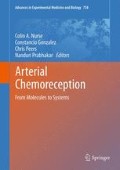Abstract
Hypoxia inducible factor 1(HIF-1α) is the regulator of oxygen homeostasis in tissue correlated with neuroglobin (NGB) a member of the family of globins in vertebrates. The present study investigates, the expression and the location of NGB, HIF-1α in human carotid bodies, sampled at autopsy from children (mean age: 2 year ±), young (mean age: 27.5) and 4 old subjects (mean age: 73.5). The percentage of NGB positive area was higher in the old subjects (4.4 ±2.8%), as compared with the young ones (2.4 ±1.8%) and children (1.0 ±1.8%). Positive HIF-1α nuclei were detected in young and old subjects (1.0 ±0.14% vs 3.0 ±0.28%, respectively), whereas CB tissues from children did not show any HIF-1α reaction. The increase of NGB and HIF-1α expression suggests a possible role of the two oxygen sensors in the aging processes. Even though the physiological role of NGB is not well understood, it could be suggested that is act as a respiratory protein connected with HIF.
Access this chapter
Tax calculation will be finalised at checkout
Purchases are for personal use only
References
Bredt DS, Hwang PM, Snyder SH (1990) Localization of nitric oxide synthase indicating a neuronal role for nitric oxide. Nature 347:768
Burmester T, Hankeln T (2009) What is the function of neuroglobin. Exp Biol 212:1423–1428
Di Giulio C, Cacchio M, Bianchi G, Rapino C, Di Ilio C (2003) Carotid body as a model for aging studies: is there a link between oxygen and aging ? J Appl Physiol 95:1755–1758
Finkel T, Holbrook NJ (2000) Oxidants, oxidative stress and the biology of ageing. Nature 408:239–247
Gelfi C, Vigano A, Ripamonti M, Pontoglio A, Begum S, Pellegrino MA, Grassi B, Bottinelli R, Wait R, Cerretelli P (2006) The human muscle proteome in aging. J Proteome Res 5:1344–1353
Iyer NV, Kotch LE, Agani F, Leung SW, Laughner E, Wenger RH, Gassmann M, Gearhart JD, Lawer AM, Yu AY, Semenza GL (1998) Cellular and developmental control of O2 homeostasis by hypoxia-inducible factor 1-µ. Genes Dev 12:149–162
Jamieson D (1989) Oxygen toxicity and reactive oxygen metabolites in mammals. Free Radic Biol Med 7:87–108
Leiser SF, Kaeberlein M (2010) The hypoxia-inducible factor HIF-1 functions as both a positive and negative modulator of aging. Biol Chem 391:1131–1137
Martinelli M, Winterhalder R, Cerretelli P, Howald H, Hoppeler H (1990) Muscle lipofuscin content and satellite cell volume is increased after high altitude exposure in humans. Experientia 46:672–676
Porzionato A, Macchi V, Guidolin D, Parenti A, Ferrara SD, De Caro R (2005) Histopathology of carotid body in heroin addiction possible chemosensitive impairment. Histopathology 46:296–306
Porzionato A, Macchi V, Parenti A, Matturri L, De Caro R (2008) Peripheral chemoreceptors: postnatal development and cytochemical findings in sudden infant death syndrome. Histol Histopathol 23:351–365
Prabhakar NR, Fields RD, Baker T, Fletcher EC (2001) Intermittent hypoxia: cell to system. Am J Physiol Lung Cell Mol Physiol 281:524–528
Rivner MH, Swift TR, Malik K (2001) Influence of age and height on nerve conduction. Muscle Nerve 24:1134–1141
Semenza GL (1999) Regulation of mammalian O2 homeostasis by hypoxia-inducible factor 1. Annu Rev Cell Dev Biol 15:551–578
Sohal RS, Toy PL, Allen RG (1986) Relationship between life expectancy, endogenous antioxidants and products of oxygen free radical reactions in the housefly, musca domestica. Mech Aging Dev 36:71–77
Verratti V, Di Giulio C, Bianchi G, Cacchio M, Petruccelli G, Artese L, Lahiri S, Iturriaga R (2009) Neuroglobin in aging carotid bodies. Adv Exper Med Biol 648:191–195
Wickens AP (2001) Ageing and the free radical theory. Respir Physiol 128:379–391
Acknowledgment
This paper is dedicated to the memory of Prof. Sukhamay Lahiri, for his example in science and in life.
Author information
Authors and Affiliations
Corresponding author
Editor information
Editors and Affiliations
Rights and permissions
Copyright information
© 2012 Springer Science+Business Media Dordrecht
About this paper
Cite this paper
Di Giulio, C., Zara, S., Cataldi, A., Porzionato, A., Pokorski, M., De Caro, R. (2012). Human Carotid Body HIF and NGB Expression During Human Development and Aging. In: Nurse, C., Gonzalez, C., Peers, C., Prabhakar, N. (eds) Arterial Chemoreception. Advances in Experimental Medicine and Biology, vol 758. Springer, Dordrecht. https://doi.org/10.1007/978-94-007-4584-1_36
Download citation
DOI: https://doi.org/10.1007/978-94-007-4584-1_36
Published:
Publisher Name: Springer, Dordrecht
Print ISBN: 978-94-007-4583-4
Online ISBN: 978-94-007-4584-1
eBook Packages: Biomedical and Life SciencesBiomedical and Life Sciences (R0)

